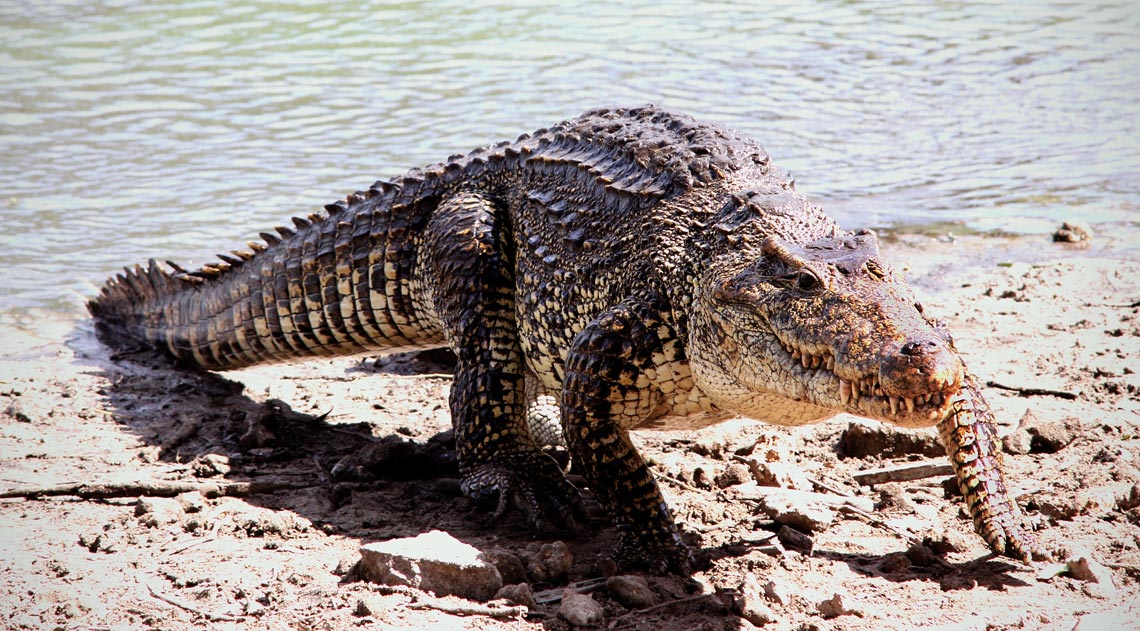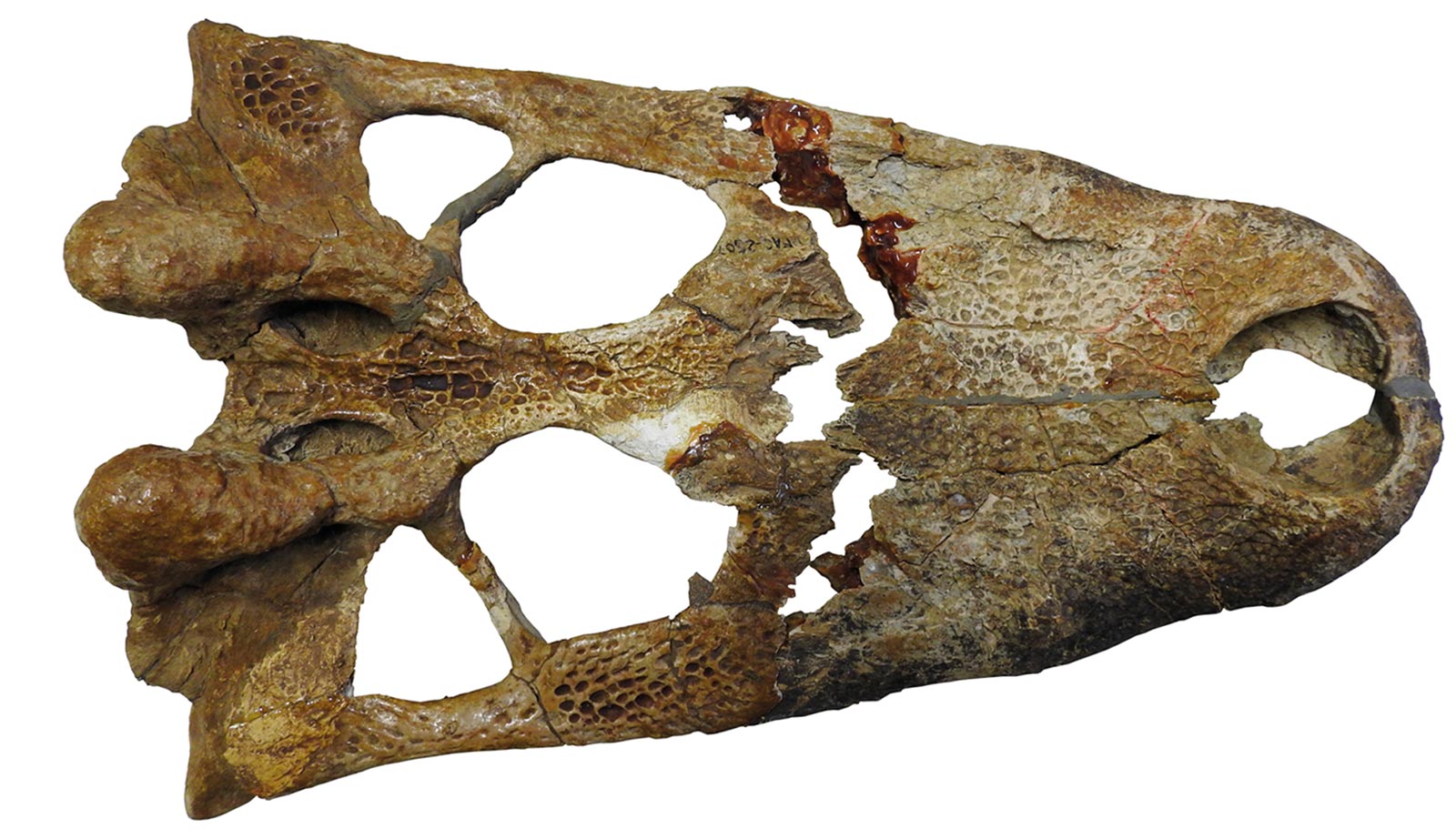A crocodile with a unique appearance lived between 11 million and 8.5 million years ago in part of what today is the southwest of the Brazilian Amazon. At three to four meters (m) from muzzle to tail, with a skull almost 60 centimeters (cm) long, it was about the size of a black caiman (Melanosuchus niger), the largest remaining species from this group of South American reptiles. It probably fed on fish, mollusks, snakes, and medium-sized mammals, as well as turtles. Its most striking feature, however, was the two protrusions on top of its head, similar to the horns of a giraffe. The Brazilian researchers who described the new species in an article published in the Journal of Vertebrate Paleontology in January named the species Acresuchus pachytemporalis, which roughly translates to “thick-templed crocodile from Acre.”
Protrusions on top of the skull are not exclusive to this species of crocodilian, a group of reptiles that emerged just over 200 million years ago—a number of extinct species, such as those of the genus Mourasuchus, as well as other living species, such as the Cuban crocodile (Crocodylus rhombifer), also share this characteristic. “The protuberances of the Acresuchus, however, are the largest ever observed in living or extinct crocodilians,” says paleontologist Annie Schmaltz Hsiou, from the Ribeirão Preto campus of the University of São Paulo (USP-RP), one of the authors of the article describing the new species.
“We suspect that the horns of the Acresuchus were a feature that distinguished males from females and were used during mating rituals,” says paleontologist Giovanne Cidade, a PhD student being supervised by Hsiou and coauthor of the article.
The new species was described based on an almost complete skull. Paleontologist Jonas Pereira de Souza Filho, from the Federal University of Acre (UFAC), found the fossil in 1989 during an excavation on the eastern bank of the Acre River in the municipality of Senador Guiomard, 30 kilometers south of the state capital, Rio Branco. Ten other fossilized Acresuchus skulls have also been found—nine in Acre and one in the Amazon—but all are less complete. Paleontologist Marcos Bissaro Junior, from the Ribeirão group, dated microscopic grains of zircon from two locations of the geological layer where the fossils were found. The results suggest that the Amazon specimen is older and lived about 11 million years ago, while those found in Acre are 8.5 million years old.
The first Acresuchus fossil remained in the UFAC collection awaiting detailed analysis for 30 years, during which time two other names were suggested for the species. At a congress in 1991, Souza Filho and French paleontologist Jean Bocquentin-Villanueva called it Caiman niteroiensis in reference to Niterói, the location in Senador Guiomard where the skull was found. When he defended his PhD thesis in 1998, Souza Filho changed its name to Caiman pachytemporalis due to the protrusions on its head. None of the names are official yet because they have not been published in a scientific journal, as required by the International Code of Zoological Nomenclature.

Gerry Zambonini / Wikimedia Commons
The cuban crocodile, which moves its head so as to show the protrusions of its skull during mating ritualsGerry Zambonini / Wikimedia CommonsAn analysis of 187 anatomical features of 93 live and extinct crocodilian species indicates that Acresuchus, a medium-sized predator, is the closest relative of the extinct Purussaurus, the largest known crocodile, which reached as much as 12.5 m in length. Researchers believe that Acresuchus, which emerged before Purussaurus, was a transitionary species between the smaller and larger crocodilians.
Diverse species and forms
The official description of Acresuchus brings to 31 the number of species of these predators that lived in South America in the Miocene period between 23 million and 5.3 million years ago. Only one—the broad-snouted caiman (Caiman latirostris)—has survived to this day. Five other more recent species of these reptiles also live in Brazil today. “Fossil records show that crocodilians were at the height of their diversity during the Miocene geological period,” says Cidade. In a review article published in the Journal of South American Earth Sciences in December 2018, before the Acresuchus was officially described, Cidade identified 30 crocodilian species that lived in South America in the Miocene.
“The diversity of life really exploded at the end of that period,” says Argentinean paleontologist Mario Cozzuol, from the Federal University of Minas Gerais (UFMG). The environment at the time was highly favorable to the emergence of new species. The continents already occupied their current position, but the landscape of South America was unique. The central region of the Andes was rising, depositing large volumes of sediment in the vast plains and wide rivers that stretched from Venezuela to northern Argentina and Uruguay (see Pesquisa FAPESP issue no. 125). It was a super-wetland roughly the size of Europe, composed of lakes, marshes, grassy fields, and sparse forests.
In a review article published in the journal Earth-Science Reviews in 2010, Cozzuol and Argentine geologist Edgardo Latrubesse, from the University of Texas, USA, listed 224 genera of land and water animals—not including fish—that lived in South America at the end of the Miocene. Two of the most diverse groups were the armadillos and sloths, with 62 genera, and rodents, with 48. Hsiou and her team have described three new species of Miocene rodents since 2012, all related to the current species, the pacarana.
According to Hsiou, such a large variety of crocodilians would only be possible with a combination of the right environmental conditions and high diversity among other animals. “To put it simply,” says Cozzuol, “there was plenty of food available at the time, of every possible size.”
Project
The Squamata (Reptilia, Lepidosauria) of the Cretaceous and Tertiary (Paleogene/Neogene) periods in the Bauru, Aiuruoca, and Acre basins: Systems, evolution, and paleoenvironments (nº 11/14080-0); Junior Researcher Program; Principal Investigator Annie Schmaltz Hsiou (USP-RP); Investment R$733,129.66 (for the entire project).
Scientific article
SOUZA-FILHO, J. P. et al. A new caimanine (Crodcodylia, Alligatoroidea) species from the Solimões Formation of Brazil and the phylogeny of Caimaninae. Journal of Vertebrate Paleontology. 29 jan. 2019.
BISSARO-JÚNIOR, M. C. et al. Detrital zircon U-Pb geochronology constrains the age of Brazilian Neogene deposits from Western Amazonia. Palaeogeography, Palaeoclimatology, Palaeoecology. v. 516, p. 64-70. 15 Fev. 2019.
CIDADE, G. M. et al. The crocodylomorph fauna of Cenozoic of South America and its evolutionary history: a review. Journal of South American Earth Sciences. v. 90, p. 392-411. On-line. 27 Dez. 2018.
LATRUBESSE, E. M. et al. The late Miocene paleogeography of the Amazon basin and the evolution of the Amazon river system. Earth-Science Review. v. 99, p. 99-124. Mai. 2010.
